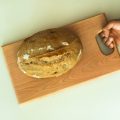Trouble in baking paradise? Forgot to feed sourdough starter a couple of times, or more? Well fear not, because if you’ve happened to forget a sourdough starter feeding, all is not lost. Here are some simple ways to fix this, and make your life much easier!

Table of Contents
- Sourdough Starter Feeding & Maintenance
- What Happens If I Forgot To Feed Sourdough Starter?
- Long-Term Sourdough storage
- Reviving Sourdough Starter
- Forgetting To Feed Your Starter
- FAQs
Sourdough Starter Feeding & Maintenance
As an avid sourdough baker, you’re probably aware of the immense responsibility that comes with taking care of sourdough starters. And to achieve a healthy starter, you’ll need to take your time with it.
You must decide how often you’ll be baking so that you can put a plan in place, especially when it comes to storing sourdough starter with hopes of successfully reviving it later on.
Daily Baker
If you like to bake sourdough bread on a daily basis, then you’ll want to keep your starter at room temperature and feed it every day. This will keep your starter warm and active, whenever you’re ready to use it.
You can also play around with the starter’s feeding schedule, once you’ve become familiar with your starter and how much it likes to be fed!
Weekly or Less Frequent Baking
Keep your starter refrigerated, as this slows down the fermentation time, and allows you to take a litte break.
Simply remove the starter from the fridge, stir and feed, then rest for 12-24 hours at room temperature before beginning your sourdough recipes.
What Happens If I Forgot To Feed Sourdough Starter?
Much like any living organism, when left unfed, the sourdough starter will begin to deteriorate. Often this is displayed through signs of molding, pungent smells of nail polish remover, and more. If your sourdough looks, smells, and feels like it has gone bad, then it’s best to throw it away.
- Look: If your starter has any type of mold growing on the surface, then toss it out and start over. If your starter has a dark grey or black hooch, then it’s completely fine, however, if the hooch is tinged pink, then toss it out immediately.
- Smell: If the starter smells like vinegar, alcohol, or even nail polish remover, then it’s pretty safe to use unless it has a musty or moldy smell, then you’d have to toss it and start over.
- Feel: If your starter had been stored in the refrigerator, then it should be a thin liquid. However, if it is thick or chunky, then throw it away.
Long-Term Sourdough storage
You can always put away your sourdough starter for longer periods, until you’re ready to use it again.
Here’s some of the ways to do this:
Freeze Your Sourdough Starter
Freezing sourdough starter is a quick and easy way to take a break from sourdough baking. It’s super easy to do, and requires no feeding until thawed.
To revive the starter, set it on the kitchen counter, wait for it to thaw at room temperature before feeding it with equal parts starter, flour and water.
Dry Your Sourdough Starter
This one might be a tad tedious, but the yeasts aren’t affected as much. Thinly spread the starter on a baking tray, and dry in a hot oven, or dehydrator.
To revive the dried sourdough starter, combine equal parts dried starter and water. Let the starter re-hydrate, then feed it with equal parts bread flour, or wheat flour, and water.

Reviving Sourdough Starter
Say you’ve had your starter for a couple of months, and left it in the refrigerator for a few weeks. here’s how to revive an old starter:
- Remove the unfed sourdough starter from the fridge, and let it come to room temperature.
- If the starter has pink mold or smells off, then get rid of it immediately.
- If the starter passes the float test, stir in the hooch or pour it off.
- In a clean jar, combine 50g of unfed starter with 50g of warm water, then stir until well combined.
- Set the starter in a warm place for 12 hours, then feed it again. In a clean jar combine 50g starter, 50g water, and 50g of flour.
- Keep a close eye on the starter for any signs of activity. Your starter may seem a bit sluggish at first, but with time you should start to notice some activity.
- If the starter doubles within 12 hours, wait 24 hours before feeding it again.
- Once you’ve revived the starter, it should be maintained on the counter and fed every 24 hours for 4-5 days. This will help revive your starter back to its healthy state.
- Make sure you feed your starter regularly once you’ve placed it back in the fridge after using it to bake some sourdough bread recipes.
Forgetting To Feed Your Starter
If you’ve forgotten to feed your sourdough starter, there’s no need to panic. In fact it may be time to temporarily put your starter away until you’re ready to bake again. Consider freezing or dehydrating your starter.
You can also make sourdough bread without a starter, did you know?
And here’s a step by step beginner sourdough recipe if you’d like to reset!
FAQs
How Long Can Sourdough Starter Go Without Feeding?
Two months. You can store your starter in the refrigerator and feed it once a week. If you don’t plan to bake with it often, then you can simply take the active starter and refrigerate it for 2 months without feeding.
Can I Use Sourdough Starter That Hasn’t Been Fed?
Not necessarily, as this will all depend on how long the starter has gone without a feed. If your starter hasn’t been fed for more than 2 weeks, then you might want to feed your starter a couple of times before using it.
Can You Feed Sourdough Starter Two Days In A Row?
Yes certainly. For best results, feed your starter two days in a row before baking.
How Do You Revive A Dead Sourdough Starter?
To revive a dead or old sourdough starter, simply feed the starter with fresh flour and water, and be consistent with the feedings. Your starter should be alive and thriving in no time!





